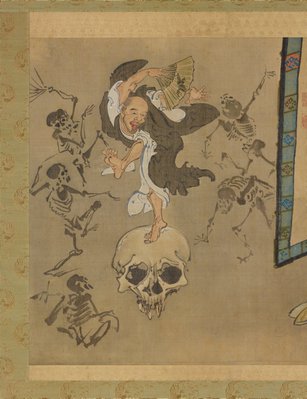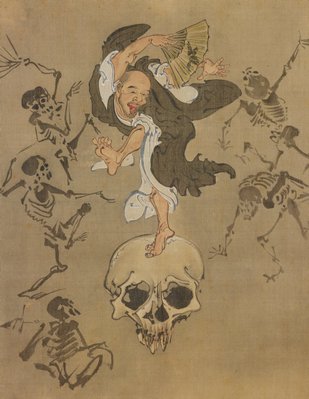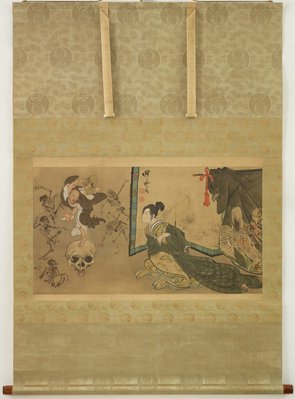



-
Details
- Place where the work was made
-
Japan
- Period
- Meiji period 1868 - 1912 → Japan
- Date
- early 1880s-mid 1880s
- Media category
- Painting
- Materials used
- hanging scroll: ink, metallic pigments, and colour on silk
- Dimensions
- 54.6 x 98.1 cm image; 168.0 x 124.0 cm overall (including roller)
- Signature & date
Signed: Seisei Kyōsai
- Credit
- Purchased with funds provided by the Art Gallery of New South Wales Foundation and the Jean Milner and Mary Tancred Bequests 2019
- Location
- Not on display
- Accession number
- 6.2019
- Copyright
- Artist information
-
Kawanabe Kyōsai
Works in the collection
- Share
-
-
About
The artist Kawanabe Kyōsai was known during his lifetime for his political satire, artistic skill and eccentricity. Although trained in the established Utagawa and Kanō schools, the artist worked independently and produced some of the most imaginative images of the late Edo and early Meiji periods. Kyōsai was primarily a painter but also designed exceptional prints. He was a close friend and teacher of the English architect Josiah Conder (1852–1920) who lived in Japan from 1877 until his death.
The Hell Courtesan (Jigoku-dayū) derives from legends of a 15th-century woman who dressed in robes decorated with images of the Buddhist hells. One of the most recognisable figures of supernatural Japan, she was a devout Buddhist whose faith was inspired by the Zen monk Ikkyū of the same period. Ikkyū is still much admired in Japan for his anti-establishment behaviour. In this painting Ikkyū is shown dancing on a skull.
-
Places
Where the work was made
Japan
-
Exhibition history
Shown in 3 exhibitions
Heaven and Hell: Salvation and Retribution in Pure Land Buddhism, San Antonio Museum of Art, , 16 Jun 2017–10 Sep 2017
Japan Supernatural, Art Gallery of New South Wales, Sydney, 02 Nov 2019–08 Mar 2020
Elemental, Art Gallery of New South Wales, Sydney, 30 Jul 2022–2024
-
Bibliography
Referenced in 5 publications
-
Anabel Dean, Look, 'Cats and courtesans', pp 70-71, Sydney, Feb 2022-Mar 2022, 71 (colour).
-
Narazaki Muneshige, Famous Choice Paintings ('Meisaku-sen'), Ukiyo-e Paintings ('Nikuhitsu ukiyo-e'), Tokyo, 1983, p. 73. fig. 7. Listed as lost and re-photographed from 1928 catalog
-
Emily Sano, Heaven and Hell: Salvation and Retribution in Pure Land Buddhism, San Antonio, 2017, 99 (colour illus.). pl. 46
-
Yasumura Toshinobu, ‘Bessatsu Taiyo' ('Kawanabe Kyōsai: Kiso no tensai eshi' [Kawanabe Kyōsai: demon of painting], 'Kisō no honryū eshi' (Master of the Eccentric and Weird), Tokyo, 2008, pp. 12, 13.
-
Second Sale: Takahashi Family Collection of April 1928, Tokyo, Apr 1928.
-
-
Provenance
Takashi Family, pre 1928, Japan
Tokyo Bijutsu Club, Apr 1928, Tokyo/Japan, offered for sale in the auction titled ‘Second Sale: Takahashi Family Collection of April 1928’
Private Collection, Apr 1928-2007
Sebastian Izzard LLC, 2007-2008, New York/United States of America
Roger Weston, 2008-2017, Chicago/Illinois/United States of America
Sebastian Izzard LLC, 2017, United States of America, purchased from Roger Weston. Purchased by the Art Gallery of New South Wales, Sydney, Aug 2019.




